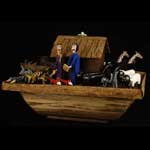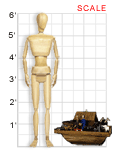VAM galleries including this work:
Kentucky Museum of Art and Craft | World of the Spirit | Art Through Time || VAM Home
Minnie Adkins (Kentucky, b. 1934) and Garland Adkins (Kentucky, 1928-1998)
NOAH’S ARK, 1992
Carved and painted wood; 33" X 24"
Kentucky Museum of Art and Craft
This piece is a great example of the partnership between Garland and Minnie Adkins. This husband-and-wife team lived in the hills of Elliott County, Kentucky, for more than 40 years. Minnie had carved since she was a little girl, and Garland began carving after he was laid off from a job. Encouraged by public reaction to their work in the 1970s, they began going to craft shows and collaborating on numerous works. Generally, Garland would rough out the shape of the piece with a chainsaw and drawknife, and Minnie would finish the details with her trusty pocketknife. The Adkins’ work is sold in galleries across the country and can be found in the homes of Bill Cosby, Oprah Winfrey, and Barbara Streisand.
In this work, they interpret a familiar Bible story, depicting Noah and his family along with a number of animals. While the piece includes the foxes, bears, and possums that Minnie and Garland have both been known for creating, they have also added more exotic breeds to the lineup. Like many of the couple’s works, the carvings are painted in rich, glossy colors.
About the Artist
Minnie Adkins traces her interest in making things back to her childhood, when she would watch the men in her community whittle. Carving is not traditionally a female pastime, but Adkins began carving at an early age, making small twig roosters, hand-sized birds, and other small objects. While she and her first husband, Garland, lived in Fairborn, Ohio, from the 1950s into the 1970s, she continued carving, giving most of her work away to family and friends and occasionally selling pieces at flea markets.
In 1984, Adkins took some small carvings to a gallery in Morehead, Kentucky, and the gallery began handling some of her pieces. In 1985, her work became part of the folk art collection at Morehead State University—which would become the Kentucky Folk Art Center. Husband Garland helped her with various parts of the process until his death in 1997, and from the early 1980s until 1997 all of her work was signed “G&M Adkins.” (One of Garland Adkins’ solo works, Horse, is also featured in our Kentucky Folk Art Center gallery.)
Over the years, Minnie Adkins has received several prestigious awards, including a Kentucky Governor’s Award in the Arts Individual Artist Award. Her work has been exhibited widely and is in several museum collections. She is well known for her “twig” roosters, ranging in height from three inches to four feet, and for carved and painted wooden animals up to 30 inches long. Most of her wood carvings are painted.
Adkins also has encouraged many other Eastern Kentucky folk artists to sell and exhibit their work. In 1987, she and Garland began hosting an annual folk art fair, “A Day in the Country,” at their home. The event is now presented by the Kentucky Folk Art Center, attracting approximately 50 folk artists and hundreds of collectors to Morehead each June.
Minnie is remarried to Herman Peters, a retired master welder who makes metal versions of her animal forms, mostly out of recycled cast-iron (“black”) pipe. The couple live and work near Isonville.
Minnie talks about her work, the Day in the Country fair, and shows how she makes roosters on the Visual Arts Toolkit video segment “Wooden Animals: Minnie Adkins,” found in Part 5: Folk/Traditional Arts of the Spectum of Art DVD. Kentucky Museum of Art and Craft curator Brion Clinkingbeard discusses Noah’s Ark in the video segment “The Artist’s Point of View, Part 2” on Responding to Visual Art.
Classroom Ideas
Discussion: Describe this work. How did the artists use the elements of art in the piece? How well do you think it reflects the story of Noah’s ark? Compare this work to Hugo Sperger’s painting Noah’s Ark in the Kentucky Folk Art Center gallery of the Kentucky Virtual Art Museum. Also, compare the animal carvings to Minnie Adkins’ Fox in the KFAC gallery. Do you see similarities and differences in style?
Activities: Take a “picture walk” through the book Bright Blue Rooster (Down on the Farm) by Minnie Adkins and Mike Norris. Make predictions about what happens in the text based on the illustrations, then read the story. Discuss your own experience and knowledge about the subject. Choose a page in the book that made you think of a personal connection. Draw your thoughts on a large piece of drawing paper.
Links
More information and images of Adkins’ work, along with advice on collecting folk art, can be found at the Self-Taught Folk Art web site.
[alumnus.caltech.edu/~dacrotty/adkins.html]
When I Win the Doctor Thing, an article on Adkins by Kentucky Folk Art Center Curator Adrian Swain, can be found at the Folk Art Society of America web site.
[www.folkart.org/mag/adkins/adkins.html]
See more images of works by Minnie and Garland Adkins at the Jane’s Addictions visionary art web site.
[www.janesaddictions.com/adkins01.htm]
A biography and numerous images of Adkins’ work are included in Minnie’s Gallery at folk artist Jim Lewis’ web site.
[victorian.fortunecity.com/operatic/611/minniesgallery.htm]
Resources relating to the story of Noah’s Ark can be found at DLTK’s Printable Crafts for Kids.
[www.dltk-bible.com/genesis/chapter6-index.htm]




